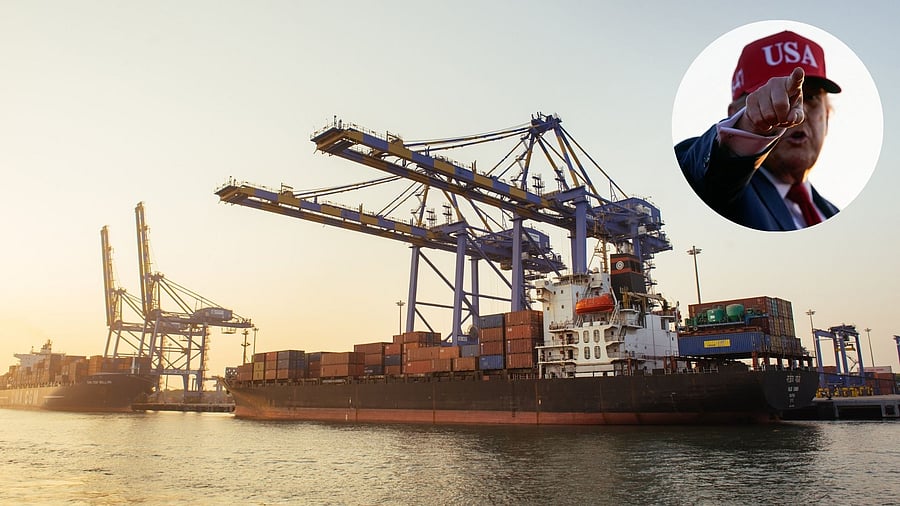
Full defiance means continuing current Russian oil import levels, regardless of US threats.
Credit: iStock, Reuters Photo
The Donald Trump administration’s recent threat of penalty in response to India’s continued oil imports from Russia is a textbook case of trade-offs between returns and risks. The United States has also announced a 25 per cent tariff on imports from India. The US tariff threats target high-value and/or labour-intensive exports, including electronics, pharmaceuticals, and textiles.
Clearly, the magnitude of the risk in India’s oil procurement strategy has increased: approximately $87 billion in India’s export revenue from the US now faces a potential slowdown. In comparison, India saves around $5-7 billion annually in energy costs from Russian oil.
India’s strategic move in crude oil procurement — from negligible Russian oil purchases before 2022 to over 2 million barrels daily (about 40 per cent of crude oil imports) has saved the country billions of dollars over the last three years.
Now, how should India mitigate risks from US sanctions while managing its energy needs?
The strategic dilemma
From a game theory perspective, India faces three primary strategic choices, each with distinct payoff structures and risk profiles.
Full compliance with the US demands would require the termination of Russian oil imports and the sourcing of oil from alternative suppliers. This is neither feasible nor likely. The specifics, scope, and implementation of any trade deal with the US, if India were to comply with US demands, are unclear. The recent experience of other countries that have entered trade deals with the US serves as a cautionary example of potentially inequitable terms in such deals.
Full compliance would also signal an acceptance of the US pressure, inviting similar coercion across other policy domains, undermining India's strategic autonomy in defence procurement, technology partnerships, and regional diplomacy.
In contrast, full defiance means continuing current Russian oil import levels, regardless of US threats, while maximising short-term energy cost savings and accepting potential US retaliation.
The initial arbitrage opportunity for India in 2022 was compelling, as Russian crude oil was available at a discount of approximately $30 per barrel relative to the Brent benchmark. Even last year, India's oil import bill contracted despite stable volumes, reducing current account deficit pressures and inflation pass-through effects on the domestic economy.
Russia's ability to offer sustained deep discounts now, however, is structurally limited. Sanctions pressure, higher production costs, and freight insurance premiums, as well as competing demand from China and Turkey, are likely to keep discounts low. Recently, India’s State-owned refiners seem to have paused new Russian contracts as margin compression makes procurement uneconomical. With the cost-benefit trade-off once again tapering against benefits, full defiance is neither a wise option for India nor economically rational.
The middle path
The third strategy would involve strategic diversification, gradually reducing Russian oil share to 15-20 per cent of total imports over the next two years while expanding alternative supplier relationships. The mixed strategy preserves partial cost advantages from Russian discounts while limiting the magnitude of the US penalty.
Recent experiences also suggest that the Trump administration's threats may represent pressure tactics rather than a policy that is fully implemented. Tariffs on imports from India and other countries are too disruptive to the US economy, resulting in higher costs of intermediate inputs for US firms and higher prices for final goods imports for US citizens, which in turn lowers domestic demand. This will lead to an eventual slowdown in the US economy — a risk that the US administration will have to consider.
Thus, the probability-weighted expected costs of the tariff and the penalty threats to India and other countries depend critically on the credibility of the threat when the US economic slowdown begins. If threats lack credibility, India will have more time to diversify its oil imports.
Long-term energy security needs long-term thinking
Regardless of the US sanctions and penalty threats, diversification reduces single-supplier dependence, and improves energy security. Over-concentration in any single supplier creates systematic vulnerabilities that rational energy procurement policy should avoid.
India's energy demand, which is projected to increase rapidly, requires reliable and scalable supply relationships. Diversified procurement is likely to create competitive pressure among suppliers, potentially resulting in better long-term pricing compared to relying on a single supplier. Rather than choosing sides between the US and Russia, India can preserve relationships with multiple partners while avoiding excessive dependence on any single country.
From a game theory perspective, therefore, strategic diversification emerges as India's dominant strategy across multiple scenarios. Whether or not the US implements threatened penalties, diversification provides superior risk-adjusted returns compared to binary compliance or defiance strategies.
Overall, for sustained economic growth and competitiveness, India should voluntarily adopt freer trade as part of its development strategy, rather than as a concession to external demands. The Budget 2025 announcements, with a move toward tariff rationalisation and the lowering of trade barriers, are a step toward acknowledging the same.
Vidya Mahambare is Union Bank Chair Professor of Economics and Director, Research, Great Lakes Institute of Management, Chennai.